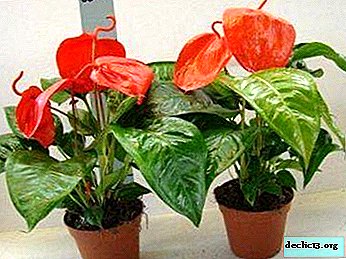Do not throw bouquets of roses! How to plant a flower if it sprouted in a vase?

Sometimes it happens that the presented roses in a vase stand for so long and by themselves are so strong that they begin to sprout.
Although the roots that have appeared are still weak, many gardeners have a question: "What should I do? Is it possible to grow a whole bush from a sprouted rose?"
This article will try to answer all these questions. We will talk about why roses sprout, whether they can be specially made to take root in a vase, and also what to do in order to plant young shoots on their own.
What flowers can sprout?
Roses that have been in the store for a long time will never sprout: there are often added to the water drugs that extend the life cycle of the plant, but negatively affect root formation. As a rule, in such cases, the shoot bottom blackens, or the entire stem slightly frowns. Such flowers will never let the roots. Flowers purchased on March 8 are more likely to root: they do not lie on the store counter, and spring only contributes to active vegetation, however, like summer.
It should also be noted right away: roots can appear on the stem of almost any rose, but this does not guarantee that it will be possible to get a new plant, especially when it comes to Dutch hybrids. Most varieties imported from abroad are treated with special preparations that slow down the process of withering of the plant, but also reduce its ability to root. Therefore, it is most likely that they will leave roots (and later take root) in a vase of roses grown in local conditions.
Important! Rooting sprouts sprouted in a vase is a highly unreliable method of propagation. The fact is that most purchased roses are usually grafted onto other varieties of rose bushes, and this does not guarantee a 100% inheritance of the characteristics of the mother plant.The resulting rose will also be guaranteed frost resistance problems. In addition, cut plants have already spent a lot of energy on flowering, so often it seems that those who begin to produce rose roots when planting in the ground simply die.
 It is believed that the roots are more likely to appear on those stems that are placed in a vase of opaque materials (better than dark glass).
It is believed that the roots are more likely to appear on those stems that are placed in a vase of opaque materials (better than dark glass).- The water in the tank does not change, but only refills as it evaporates. Previously, you can throw a tablet of activated carbon into it.
- Water should be boiled or thawed, as pathogenic microbes are present in high doses in raw water.
- The water level in the vase is also important: if there is too much of it, the stem will most likely rot, as there will be insufficient oxygen in the container (roots form at the border of water and air).
- There must be leaves on the stem of the rose: according to experienced gardeners, it is the leaves that produce the substance similar to the root stimulation biostimulator, for example, heteroauxin. However, the leaves should not be immersed in water, otherwise they can provoke putrefactive processes.
- Naturally, in the room where the bouquet is located, it should be light and warm enough (+ 20C - + 24C).
Signs
At the tip of the rose shoot you can see callus (callus) - plant tissue formed on sections of shoots resulting from the division of the nearest living cells. Callus is a harbinger of the emergence of roots, and shoots with this plant tissue can already be sent to root in the ground.
How to "force" a flower to take root and young shoots?
In addition to all the above nuances (dark glass container, compliance with water requirements, the presence of leaves, temperature and light conditions), compliance with which is mandatory, you can add a root stimulation biostimulator to the water according to the instructions.
How to plant and grow?
What to do if the flower has sprouted?
- Prepare the tools. To plant a sprouted rose in the ground you will need:
- sharp garden knife treated with an antiseptic;
- flower pot;
- substrate;
- drainage (should occupy ¼ of the pot);
- glass jar (cut bottle or plastic bag).
 Make a stalk of a sprouted rose. How can I make cuttings for planting?
Make a stalk of a sprouted rose. How can I make cuttings for planting?- The first step is to remove the plant bud (this is done long before the planting process, as soon as the flower wilted).
- Then cut the stalk from the middle part of the shoot with 3-5 intact kidneys and a total length of 15-20 cm.
- The lower part of the stem remains with sprouted roots, but the upper is cut at a right angle at the level of 2 - 3 cm above the upper kidney.
- Handle the stalk. All leaves should be removed from the handle, leaving only a couple of the top, but they must also be shortened by ½. To prevent infection of planting material, it should be immersed in a pink solution of potassium permanganate for a day.
- Plant in a container. The tank is filled first with drainage (expanded clay, broken brick, pebbles, etc.), then with a substrate. A recess is made in the soil, into which it is easy to place the stalk 2/3 of its length and gently spread only the roots that have appeared. The handle penetrates at an angle of 45 degrees.
- Rooting. For the formation of a complete root system, it may take a different time. If the soil is warmed up, then in a month - another roots will get stronger and develop. At this point, it is entirely possible that an escape will begin to grow from the kidney.
- Provide care for the young plant. Immediately after planting the cuttings, the soil is abundantly watered, and the pot is exposed to a well-lit place, but without direct sunlight. Recommended temperature for the "engraftment" of roses should be + 25C.
As soon as a young plant grows stronger and gain strength, it can be started to care for it as an adult plant (spraying, top dressing, etc.).
Increased chances of survival
 Rose rooted in high humidity, therefore, it is advisable to increase the chances of survival of the cuttings from above to cover everything with a glass jar or plastic bag.
Rose rooted in high humidity, therefore, it is advisable to increase the chances of survival of the cuttings from above to cover everything with a glass jar or plastic bag.
Experienced flower growers recommend that the bank not be removed until it is clear that the rose has begun and has begun to grow (it produces new shoots and leaves).
And only then can the “greenhouse” be opened for a short while, gradually accustoming the young plant to the dry, unusual air of the environment. The total length of time from the moment the cutter is covered with a can until it is removed is about six months.
Problems and difficulties
The roots of roses grown in water have a completely different structure than those that appeared as a result of the rooting of a flower in the ground. Water roots are thinner, weaker, translucent, brittle and very sensitive to rot.. They can be easily injured or completely broken off when transplanted into a substrate. Therefore, when planting, you must be as careful as possible, otherwise the plant will have to go through the rooting process again, and this, as a rule, ends in failure.
The water does not contain enough oxygen, and therefore it is often possible to observe such a phenomenon: a rose "grew" sufficiently strong roots in a vase, and when planted in the soil it died, the adaptation process failed. This is the main disadvantage of rose propagation by rooting in water.
A rose sprouted in a vase can be planted both in a pot and in open ground. But you must remember that this method of reproduction is very unreliable. Therefore, do not despair if the attempt to grow a new bush was unsuccessful. Rose is a very moody flower. You should be patient and try your luck the next time.
Useful video
We offer you to watch a video on how to root a rose from a bouquet that has already sprouted in a vase:

 It is believed that the roots are more likely to appear on those stems that are placed in a vase of opaque materials (better than dark glass).
It is believed that the roots are more likely to appear on those stems that are placed in a vase of opaque materials (better than dark glass). Make a stalk of a sprouted rose. How can I make cuttings for planting?
Make a stalk of a sprouted rose. How can I make cuttings for planting?















